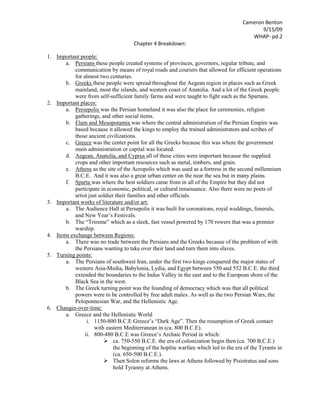
Chapter 4 Breakdowns
- 1. Chapter 4 Breakdown: Important people: Persians these people created systems of provinces, governors, regular tribute, and communication by means of royal roads and couriers that allowed for efficient operations for almost two centuries. Greeks these people were spread throughout the Aegean region in places such as Greek mainland, most the islands, and western coast of Anatolia. And a lot of the Greek people were from self-sufficient family farms and were taught to fight such as the Spartans. Important places: Persepolis was the Persian homeland it was also the place for ceremonies, religion gatherings, and other social items. Elam and Mesopotamia was where the central administration of the Persian Empire was based because it allowed the kings to employ the trained administrators and scribes of those ancient civilizations. Greece was the center point for all the Greeks because this was where the government main administration or capital was located. Aegean, Anatolia, and Cyprus all of these cities were important because the supplied crops and other important resources such as metal, timbers, and grain. Athens as the site of the Acropolis which was used as a fortress in the second millennium B.C.E. And it was also a great urban center on the near the sea but in many plains. Sparta was where the best soldiers came from in all of the Empire but they did not participate in economic, political, or cultural renaissance. Also there were no poets of artist just soldier their families and other officials. Important works of literature and/or art: The Audience Hall at Persepolis it was built for coronations, royal weddings, funerals, and New Year’s Festivals. The “Trireme” which as a sleek, fast vessel powered by 170 rowers that was a premier warship. Items exchange between Regions: There was no trade between the Persians and the Greeks because of the problem of with the Persians wanting to take over their land and turn them into slaves. Turning points: The Persians of southwest Iran, under the first two kings conquered the major states of western Asia-Media, Babylonia, Lydia, and Egypt between 550 and 552 B.C.E. the third extended the boundaries to the Indus Valley in the east and to the European shore of the Black Sea in the west. The Greek turning point was the founding of democracy which was that all political powers were to be controlled by free adult males. As well as the two Persian Wars, the Peloponnesian War, and the Hellenistic Age. Changes-over-time: Greece and the Hellenistic World 1150-800 B.C.E Greece’s “Dark Age”. Then the resumption of Greek contact with eastern Mediterranean in (ca. 800 B.C.E). 800-480 B.C.E was Greece’s Archaic Period in which: ca. 750-550 B.C.E. the era of colonization begin then (ca. 700 B.C.E.) the beginning of the hoplite warfare which led to the era of the Tyrants in (ca. 650-500 B.C.E.). Then Solon reforms the laws at Athens followed by Pisistratus and sons hold Tyranny at Athens. 499-494 B.C.E. the Ionian Greeks rebel against Persia then in 490 B.C.E. the Athenians check Persian punitive expedition at Marathon. 480-323 B.C.E. was Greece’s classical period in which: 477 B.C.E. Athens becomes leader of the Delian League. Followed the Pericles’s dominant at Athens which leads to Athens completing of evolution to democracy in 461-429 B.C.E. After the switch to democracy the Peloponnesian War takes places in 431-404 B.C.E. which leads to the trial and execution of Socrates. Then in 359 B.C.E. Philip II becomes king of Macedonia in which he takes control of Greece in 338 B.C.E. And after the capture of Greece the end of democracy in Athens followed in 317 B.C.E. ca. 300 B.C.E. the foundation of the Museum in Alexandria is built. And in 200 B.C.E. the first Roman intervention in the Hellenistic East followed by the Roman annexation of Egypt and the last of the Hellenistic kingdom in 30 B.C.E. Continuities-over-time: Persian Empire In ca.1000 B.C.E. the Persians settle in southwest Iran. Then Cyrus’s rule from 550-530 B.C.E. in which he overthrow the Medes in 550 B.C.E. conquers Lydia in 546 B.C.E. take control of Babylonia in 539 B.C.E. After him came the reign of Cambyses in 530-522 B.C.E. in which he took over Egypt to the reign of Darius but in 522-486 B.C.E. which lead to the Xerxes’ reign in 480-479 B.C.E. in which he tries to invade Greece. Then in 387 B.C.E., King’s Peace makes Persia an arbiter of Greek affairs but in 334-323 B.C.E. Alexander the Great defeats Persia and creates a huge empire. And after he creates his empire the Hellenistic period takes place from 323-30 B.C.E. Summary: Both the Greece (1150-300 B.C.E.), the Hellenistic World (200-30 B.C.E.) and the Persian Empire (ca.1000-30 B.C.E.) are both started around the same time with just a 150 years difference. They were both enemies because the Persians wanted the Greeks land and turn them into slaves so they had two Persian Wars in which the Greeks won. Also the trade between the two regions was very small or was none at all. The Greeks had more changes of power then the Persians because of the different influence of the Mediterranean area and the change of power in Athens. And lastly both Greece’s and Persian’s Hellenistic period ended in 30 B.C.E. and then leveled out in the end. Reaction: My reaction to this chapter was that these even though the Persians were at the necks of Greeks both of the Empires were going through problems of their own but the Persians still wanted more land and more control. The information giving is very smooth because it describes both Empire in separate sections and then put the struggles of both together in one section and then talks about the Hellenistic World. And lastly this chapter’s detail of the Persian Wars needed to have been expanded to include more information because they were just as important to both civilizations’ changes of power and culture.